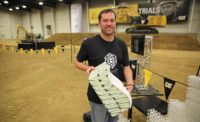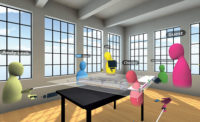Getting a full 3D visualization of a construction site is a trick that a few off-the-shelf tools can offer, but what you do next with that data is the real challenge. That’s the focus now of the reality-capture camera manufacturer Matterport, which is broadening the ways its 3D captures can be delivered for design tools, virtual reality and, eventually, full augmented reality viewing.
“There is a technology gap that Matterport is filling,” says John Chwalibog, the company’s director of AEC services. Matterport’s Pro2 camera can do full image capture and then, with a one-button press, send it to the cloud, where software converts the scans to a 3D model.
Broadening how models can be visualized is one area Matterport is exploring. Its 3D models can be exported to the GearVR and Google Cardboard virtual reality viewing platforms, a current feature it will continue to offer for free.
But VR viewing is only one step toward the goal of creating augmented reality tools, says Bob Shakib, Matterport’s vice president for strategic partnerships. He says having the 3D model already built is “very convenient” for authoring AR content because, unlike other AR creation systems that have an AR rendering engine but have to begin the AR creation process by mapping out the space, Matterport’s starting point is a fully photographed 3D model.
Matterport can then be used as an AR content-authoring platform, says Shakib. “You can attach all sorts of information to it as needed.” The scan of an area could eventually be streamed to an iPad on site, allowing a user to see information as an overlay on the real space. This could enable real-time test fitting of equipment or the checking of live sensor data.
Matterport also recently entered into a partnership with Leica Geosystems that brings 3D point clouds generated by Leica’s BLK laser scanner into Matterport’s 3D models. Chwalibog says the Leica BLK scanner offers “a stark difference” from the Pro2 in what it can capture on site. “The BLK works well outdoors, has LIDAR, and can capture those huge spaces our camera can’t,” Chwalibog says. The partnership was partially driven by customers who wanted to bring point cloud data from their existing scanners into Matterport’s 3D models, he says.








Post a comment to this article
Report Abusive Comment